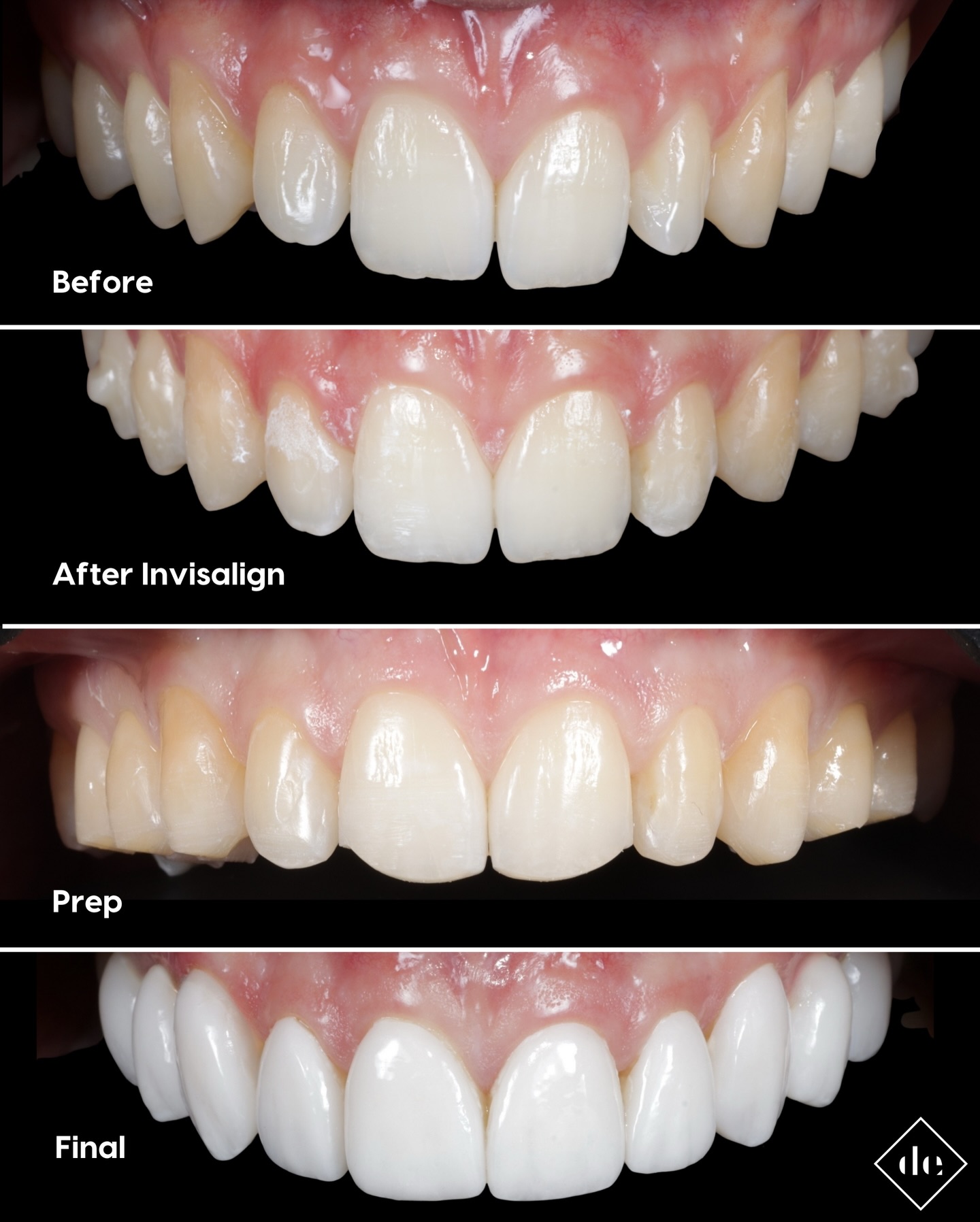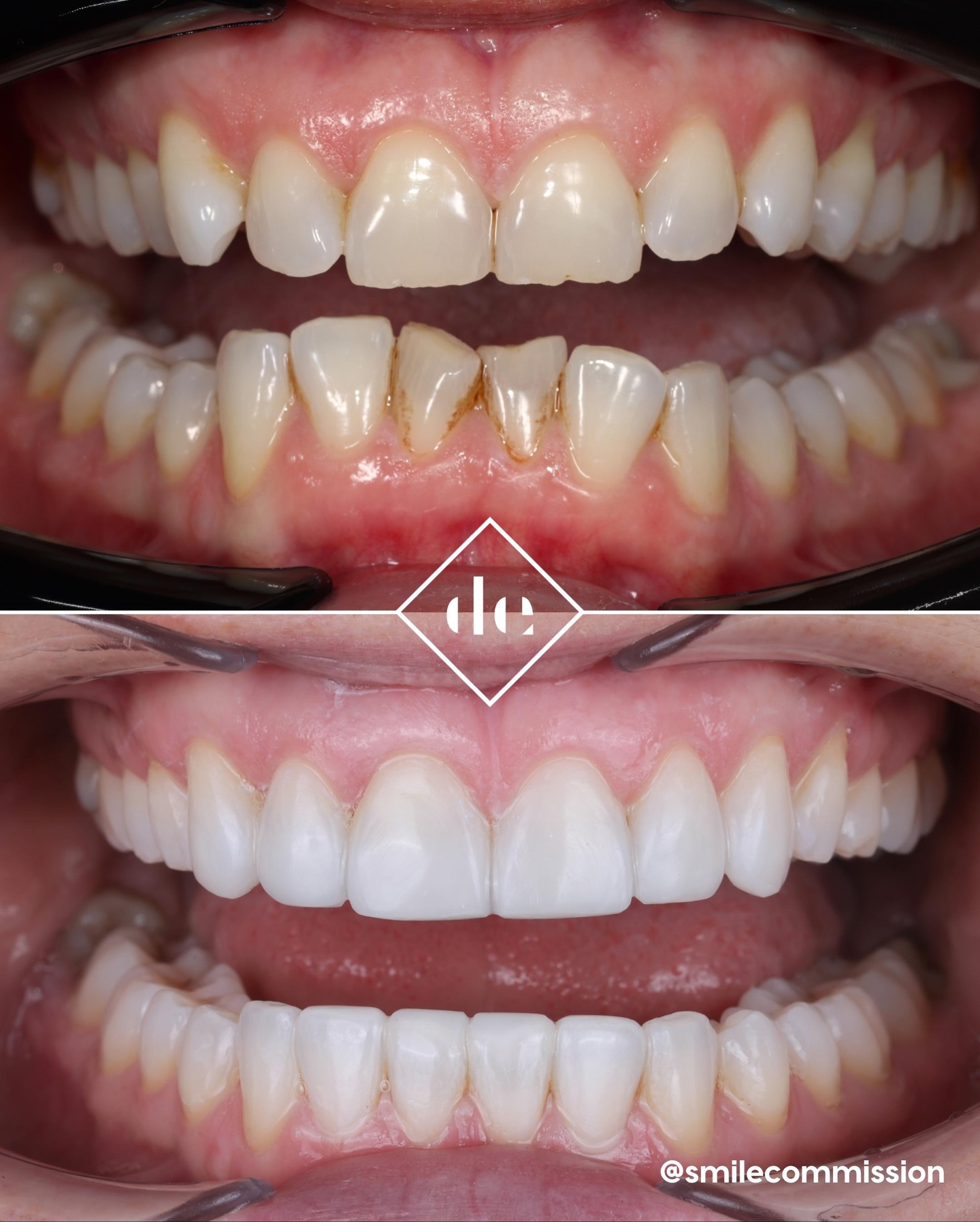There are two main types of dental veneers – composite veneers and porcelain veneers. Whilst they both share the same purpose - to create the appearance of a winning smile - there are subtle differences between their properties and the benefits they offer. In this post, we will compare them both and provide everything you need to know about composite vs porcelain veneers.
What are Composite Veneers and Porcelain Veneers?
A composite veneer is a tooth-shaded resin that is matched to the natural colour of your tooth. It is applied in layers to the surface of your tooth and sculpted directly in your mouth by a dentist. This resin is then hardened using a high-intensity light and then polished to elicit a natural appearance. Additional layers can be applied and sculpted as required to create the desired aesthetic outcome.
Composite veneers can also be used in circumstances where there is a chipped or discoloured tooth, with the layered veneer material acting as a filler for the damaged tooth. Composite veneers are non-destructive and can last for a long time. They can also be used to correct minor misalignments of your teeth, to give the appearance of a straighter smile.
Porcelain veneers, on the other hand, are custom-made, wafer-thin shells that fit directly over your teeth, acting like a cover or shield. It’s similar to having a false nail, as they create a very life-like and natural appearance, but a lot more durable.
Porcelain veneers have translucent properties, allowing them to mimic the light reflecting properties of natural enamel. This gives the overall appearance a true sense of depth, recreating the natural look of teeth while also providing strength and resilience.
Advantages of Composite Veneers vs. Advantages of Porcelain Veneers
A major benefit of composite veneers, especially in comparison to porcelain, is the cost. Usually, porcelain veneers are around twice as expensive as composite veneers. However, the primary advantage of composite veneers is that they can be fabricated as part of a Same Day Smile makeover. As they are sculpted on your teeth (composite bonding) rather than in a lab, the procedure is much less invasive and quicker, so you can have them done in a day.
Another advantage of composite veneers is that minimal prep work is required on your natural tooth, so they are not permanently altered. This means the composite material can be removed and replaced if required. With porcelain veneers, you will more than likely need to reshape your natural tooth in order to fit the veneer.
Porcelain veneers are extremely durable and are known to be stronger in comparison to composite resin. The material is highly resistant to staining and chipping. If they are maintained properly, they can last 10 to 15 years. The average lifespan of composite veneers in comparison is 5 to 7 years. Another major advantage of porcelain is the translucent quality it provides, perfectly mimicking the natural appearance of tooth enamel.
However, composite veneers are easier to reverse, fix and replace. There is also a lot more involved in the porcelain veneer procedure, as the veneers must be sculpted in a laboratory. This procedure is being improved and accelerated all the time, including with the use of CAD/CAM technologies, which speeds up the process significantly.
How Long Do Composite and Porcelain Veneers Last?
Composite veneers are much more durable today than they were in the past. As mentioned previously, on average they can last between 5 and 7 years. After that, you will more than likely need a replacement set.
If you take good care of your veneers and have good overall oral hygiene, you may be able to extend the life of your composite veneers. Regular brushing with a non-abrasive toothpaste will help. You should also try to avoid biting down on any hard objects or foods with just your front teeth.
Porcelain veneers can last between 10 and 15 years, but as with composite veneers, this lifespan can be extended with the right maintenance. Some patients can maintain porcelain veneers to last over 20 years. This is one reason why they may be chosen to fix significant discolouration or spacing issues.
The lifespan of 10 to 15 years is not guaranteed with porcelain veneers, however. Their longevity will ultimately depend on how you take care and maintain them following the procedure. If any underlying natural teeth start to decay, this can also affect how the veneers look. Therefore, it is important to maintain good oral health and hygiene.
Composite vs Porcelain Veneers
- Durability - With proper care and maintenance, porcelain veneers should last between 10 and 15 years, which is almost double the lifespan of composite veneers. While the porcelain material on its own is extremely fragile, once bonded to the tooth it becomes extremely durable. Composite is not a weak material in comparison, it is still incredibly durable, just not as resistant to chipping as porcelain is. However, if damage does occur to a porcelain veneer, it would need to be replaced. On the other hand, composite veneers can be repaired, often in one quick and easy treatment.
- Cost - Porcelain veneers are typically more expensive than composite veneers. They become even more expensive if they break of need replacing for any other reason. The placement of porcelain veneers takes more time, expertise and resources – so it makes sense they a more costly in comparison. If you regularly damage your composite veneers, or require regular repairs, the cost over time may work out the same. But with good oral hygiene and the correct maintenance, composite veneers are cheaper.
- Stain Resistance - Porcelain veneers are known to resist everyday staining from things like red wine, tea, coffee and cigarette smoke. In comparison, composite veneers do not boast the same resistance staining value. Rich or dark coloured foods can stain composite veneers over an extended period of time. Although with modern materials and advancements in technology, this is now becoming minimal.
- Procedure Time - When it comes to speed, effort and convenience, composite veneers win hands down. They are the quickest of the two dental procedures, and require very little preparation work. In fact, they can be applied chairside on the same day. Your dentist will match the material to the colour and shade of your surrounding teeth, apply it, cure it and then polish it all in one session. On the other hand, porcelain veneers typically take at least 2 visits. This is because your dentist must first take an impression of the teeth and send the resulting mould to our in-house lab, where the veneers are fabricated. A set of temporary veneers will be given to you to wear in the meantime. You’ll then come back for a second visit when your actual porcelain veneers will be bonded to your teeth.
- Procedure Preparation -To prepare your tooth for a porcelain veneer, your dentist must first remove a thin layer from the tooth surface. This means the tooth structure becomes permanently altered, which is irreversible. The procedure also takes a lot more time and involves more than one visit to your dentist. Composite veneers, on the other hand, bond directly on to the tooth surface without any preparation required. They are not damaging or destructive to the structure of the tooth at all.
- Image - Porcelain veneers have translucent properties that allow them to catch light in the same way a natural tooth does. They are also resistant to stains and much harder to chip than a composite veneer. They can also change the shade of your tooth completely, whereas a composite veneer must match the colour of your tooth. However, if porcelain veneers do chip or stain, they cannot be repaired. They must be replaced, whereas composite veneers can be fixed in a day.
The Final Verdict: Porcelain vs Composite
Both these types of veneers offer their own distinct advantages and in equal measure, so it is hard to choose between them in a final verdict. It will ultimately depend on your own goals and requirements, and the conversation you have with your dentist. Talking to a professional is the only true way of telling whether a porcelain veneer or a composite veneer is right for you. A dentist will consider your aesthetic goals, the state of your current teeth and your personal motivations.
If cost and convenience are your primary concerns, then a composite veneers treatment is probably a good fit. If cost is not a concern and you care more about aesthetics, or your teeth are more damaged, then porcelain veneers may be suitable for you.
Ultimately, both of these options offer fantastic results with confidence and smile boosting enhancements. Talk to your dentist to find out which option is best for you and your personal circumstances.
Who Can Get Veneers?
In short, most people can undergo dental veneer treatment. This dental procedure can be used to cover up imperfections in your teeth and give you an even, beautiful smile. This can include squint, crooked, chipped, misshapen, stained, or discoloured teeth. They are different to similar treatments, like dental crowns, as they do not cover the back of the tooth and crowns tend to require more trimming of the tooth.
Veneers are a good choice when teeth are in relatively good shape, and patients wish to just change their shape or colour. Crowns are usually used when teeth have more damage, like a completely broken tooth.
Ask Dental Excellence for More Information
To find out more about the options available to you with dental veneers, or any other cosmetic orthodontics, please don’t hesitate to get in touch with the team at Dental Excellence. You can also book a consultation with our experienced dentistry team to see what we can do for you.







